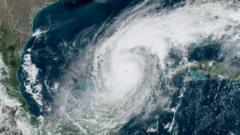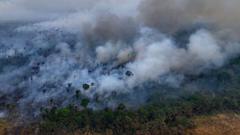A new study highlights the role of atmospheric conditions in worsening droughts, indicating a shift in agricultural practices may be necessary.
**Droughts Intensified by Atmospheric Thirst: New Research Reveals Complex Causes**

**Droughts Intensified by Atmospheric Thirst: New Research Reveals Complex Causes**
Higher temperatures and climate change are changing the dynamics of drought severity and area affected, according to recent studies.
As farmers across the Great Plains and Western regions rely on center-pivot irrigation systems, many are discovering that older irrigation methods can't meet the demands of today's increasingly hot climate. Agricultural hydrologist Meetpal Kukal from the University of Idaho noted, “There’s a gap between how much water you can apply and what the crop demands are.” Crops often dry out before water can be reapplied due to critical atmospheric conditions.
A recently published study led by hydroclimatologist Solomon Gebrechorkos at the University of Oxford revealed that the atmosphere is becoming increasingly “thirsty.” This phenomenon—coined 'atmospheric thirst'—has been linked to the increased frequency, intensity, and coverage of droughts over the past four decades. It represents a shift in our understanding of drought conditions, as traditional studies predominantly focused on rainfall alone without considering atmospheric evaporation's impact.
Droughts are characterized by an imbalance between water supply via rainfall and demand, which is impacted largely by evaporation driven by temperature, wind, humidity, and solar radiation. Dr. Gebrechorkos highlighted the inadequacy of previous models that solely considered precipitation: "It just really wasn’t detailed enough," he explained, comparing it to balancing a checkbook without accounting for expenses.
As temperatures rise, farmers and researchers alike are urged to rethink their strategies in light of this new information. Understanding the critical role of atmospheric conditions could provide vital insights needed to address the unfolding challenges posed by climate change on global agriculture.
A recently published study led by hydroclimatologist Solomon Gebrechorkos at the University of Oxford revealed that the atmosphere is becoming increasingly “thirsty.” This phenomenon—coined 'atmospheric thirst'—has been linked to the increased frequency, intensity, and coverage of droughts over the past four decades. It represents a shift in our understanding of drought conditions, as traditional studies predominantly focused on rainfall alone without considering atmospheric evaporation's impact.
Droughts are characterized by an imbalance between water supply via rainfall and demand, which is impacted largely by evaporation driven by temperature, wind, humidity, and solar radiation. Dr. Gebrechorkos highlighted the inadequacy of previous models that solely considered precipitation: "It just really wasn’t detailed enough," he explained, comparing it to balancing a checkbook without accounting for expenses.
As temperatures rise, farmers and researchers alike are urged to rethink their strategies in light of this new information. Understanding the critical role of atmospheric conditions could provide vital insights needed to address the unfolding challenges posed by climate change on global agriculture.



















